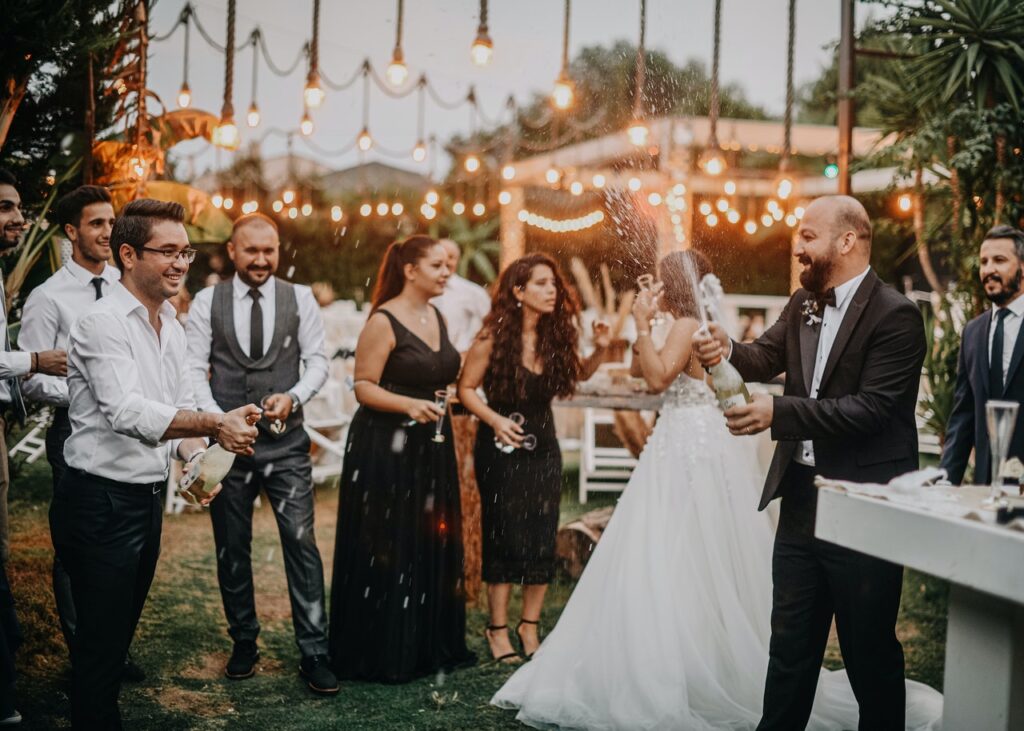
It’s important to have your closest friends and family at the altar with you on your special day. But what happens with your best friends aren’t all guys or girls? You may choose to send your sister to the bride’s side or your high school BFF to the groom’s side—and it’s OK if you do! But don’t be afraid to divide the aisle by association instead of gender. You can celebrate with your friends and family at your side by having bridesmen and groomswomen.
Tradition is a big part of wedding ceremonies. And although tradition isn’t a bad thing, it can prevent you from having the wedding that you want to have. If you want bridesmen and groomswomen at your wedding—go right ahead! There are some special considerations for such a shift in tradition, however, so we’re here to walk you through them.
First and foremost, don’t get caught up in stereotypes! It’s the most important rule of bridesmen and groomswomen. Stereotypes will make your blended wedding party more complicated than it needs to be. Don’t worry about choosing typically gender-neutral colors or gifts. Instead, choose the colors that you want, and give gifts that your wedding attendants will like and use. It really is that simple! Keep reading for other simple tips to navigate the non-traditional waters of bridesmen and groomswomen.
Attire

No matter who is in your wedding party, you’ll still want to coordinate their attire. Attendant dresses and suits are part of the wedding theme, and a focal point of the whole day. That’s why it’s important to choose attire based on side of the aisle, not gender. Before choosing, consider who will be next to each other at the altar and in photos—then base any attire decisions around that. For example, your groomswoman won’t be standing next the the bridesmaids, so their dresses don’t have to match. They don’t even have to wear a dress at all! But they do have to complement the groomsmen because they’ll be standing right next to them.
Of course, you still want the party as a whole to match, so the groomswomen dresses (or skirts or pants) shouldn’t clash with each other, either! If you’re feeling stuck, do what any couple would do: Ask your friends. Maybe your groomswoman would prefer to wear a suit, so they can match the groomsmen, right down to the ties.
Naming Conventions
While you shouldn’t get too hung up on what to call your groomswomen or bridesmen, you should choose what naming conventions to use for introductions and wedding programs. Typically, the wedding program lists the names of the wedding party and their roles. The MC will also introduce each member in the same manner at the start of the reception.

Although you can skip the role-naming part, it’s a nice way for the guests to get to know your close friends and family. Instead of nixing the roles, we recommend creating your own! You can nod to tradition with terms like man of honor, best woman, bridesman, and groomswoman. Or you can throw tradition to the wind and just label your friends and family what they are—introduce Mary as your younger sister and Matthew as your childhood best friend.
Communication
Regardless of who stands on what side of the aisle, introduce the bridal party to each other and the groom’s attendants to each other. If you’re breaking tradition for any reason—but especially with your wedding party—it’s important to let the wedding party know. You don’t need to make any official announcement, but you should clearly communicate any naming conventions so they know what (and who!) you’re talking about.
To let guests know, simply list the wedding party’s names and roles on the wedding website. If there are guests who may have a problem with a less-than-traditional wedding ceremony, it’s up to you to decide whether or not to tell them in advance. If they’ll make a scene on the day of, we recommend telling them ahead of time.
Bachelor(ette) Parties

Once again, don’t get too focused on doing what’s “normal.” After all, you’re not having a “normal” wedding! Instead, pick something that you and your bride or groom want to do—and do it! It really is that simple. It shouldn’t matter what genders are attending, so long as everyone is supporting the happy couple and having a good time.
To avoid any bachelor(ette) parties altogether, you can always throw a big, joint party with everyone from the wedding party. That way, there aren’t any sides or gender stereotypes, and everyone can get to know each other before the wedding day.
Day-of Grooming
No matter who’s in your wedding party, you’ll still need to coordinate day-of grooming. Typically, women getting their hair and/or make up done will take longer than men getting a hair cut or steam cleaning their suit. But, of course, you should always check in with your attendants. Figure out what you’ll need to accommodate and how long everyone will need on the morning of.

For example: What will everyone need to get ready? How can you share a hair stylist or makeup artist with the entire wedding party? Do you need separate rooms for everyone to change privately? Plan ahead for your wedding party so when the day comes, it can be all about you!
Conclusion
Having bridesmen and groomswomen in your wedding party may be non-traditional, but it isn’t complicated. Don’t get caught up in what’s “normal” or traditional—you’re not having a normal or traditional wedding! Instead, focus on you and your wedding party. Plan events, choose attire, and give gifts that they’ll enjoy and that reflect your vision for your big day.
What other wedding traditions do bridesmen and groomswomen affect? Share your ideas with us below!

